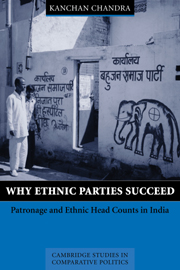Book contents
- Frontmatter
- Dedication
- Contents
- List of Maps, Figures, and Tables
- List of Abbreviations
- A Note on Terminology
- Acknowledgments
- 1 Introduction
- Part I Theory
- Part II Data
- 6 India as a Patronage-Democracy
- 7 The Bahujan Samaj Party (Bsp) and the Scheduled Castes (SCs)
- 8 Why Sc Elites Join the Bsp
- 9 Why Sc Elites Join the Bsp
- 10 Why Sc Voter Preferences Translate into Bsp Votes
- 11 Explaining Different Head Counts in the Bsp and Congress
- 12 Extending the Argument to Other Ethnic Parties in India: The Bjp, The Dmk, and The Jmm
- 13 Ethnic Head Counts and Democratic Stability
- Appendix A Elite Interviews
- Appendix B Ethnographies of Election Campaigns
- Appendix C Content Analysis
- Appendix D Description of Survey Data
- Appendix E Description of the Ecological Inference (EI) Method
- Appendix F Method Used to Estimate Ethnic Voting Patterns
- Bibliography
- Index
- Miscellaneous Endmatter
11 - Explaining Different Head Counts in the Bsp and Congress
from Part II - Data
Published online by Cambridge University Press: 19 October 2017
- Frontmatter
- Dedication
- Contents
- List of Maps, Figures, and Tables
- List of Abbreviations
- A Note on Terminology
- Acknowledgments
- 1 Introduction
- Part I Theory
- Part II Data
- 6 India as a Patronage-Democracy
- 7 The Bahujan Samaj Party (Bsp) and the Scheduled Castes (SCs)
- 8 Why Sc Elites Join the Bsp
- 9 Why Sc Elites Join the Bsp
- 10 Why Sc Voter Preferences Translate into Bsp Votes
- 11 Explaining Different Head Counts in the Bsp and Congress
- 12 Extending the Argument to Other Ethnic Parties in India: The Bjp, The Dmk, and The Jmm
- 13 Ethnic Head Counts and Democratic Stability
- Appendix A Elite Interviews
- Appendix B Ethnographies of Election Campaigns
- Appendix C Content Analysis
- Appendix D Description of Survey Data
- Appendix E Description of the Ecological Inference (EI) Method
- Appendix F Method Used to Estimate Ethnic Voting Patterns
- Bibliography
- Index
- Miscellaneous Endmatter
Summary
Previous chapters demonstrated that the success of the BSP among Scheduled Caste voters was contingent upon the representational profile of the BSP and its main competition, the Congress party. This chapter addresses the underlying question: What explains the relative ability of Congress and the BSP to incorporate Scheduled Caste elites across states and across time? Why did Congress incorporate Scheduled Caste elites into its organization and governments to a greater degree in Karnataka than in Uttar Pradesh and Punjab? And in Uttar Pradesh and Punjab, why did it not incorporate these elites even after the emergence of the BSP as a competitive threat? Why did the BSP, avowedly a Scheduled Caste party, not incorporate Scheduled Caste elites from a wider spectrum of caste categories in any of the three states at its point of entry? And why did it not subsequently move to incorporate these elites in order to improve its electoral performance?
In this chapter, I apply the model of elite incorporation developed in Part I to explain the differential ability of both parties to incorporate Scheduled Caste elites across Indian states. The incorporation of Scheduled Caste elites by the Congress party in Karnataka took place during a period when it had a competitive organizational structure. Its switch to a centralized structure following 1972, however, rendered it closed to rising Scheduled Caste elites in other states. The BSP, meanwhile, had a centralized organizational structure since its inception. In each state, therefore, it found it extraordinarily difficult to open itself to new entrants once it acquired an initial core of activists. In Uttar Pradesh, its high probability of winning since 1993 allowed it to compensate for the low probability of ascent and temporarily house elites from different Scheduled Caste categories under the same roof. In Punjab and Karnataka, however, its low prospects of winning, combined with its centralized organizational structure, rendered it closed to new elites.
Explaining Differential Incorporation in the Congress Party
Founded in 1885, the Indian National Congress exhibits significant temporal variation in its rules for intraparty advancement. The two defining rules of competitive party organizations (open membership and intraparty elections through majority rule) were introduced into Congress in 1920. This section describes the evolution of these rules and their impact on elite incorporation in the party.
- Type
- Chapter
- Information
- Why Ethnic Parties SucceedPatronage and Ethnic Head Counts in India, pp. 246 - 261Publisher: Cambridge University PressPrint publication year: 2004



